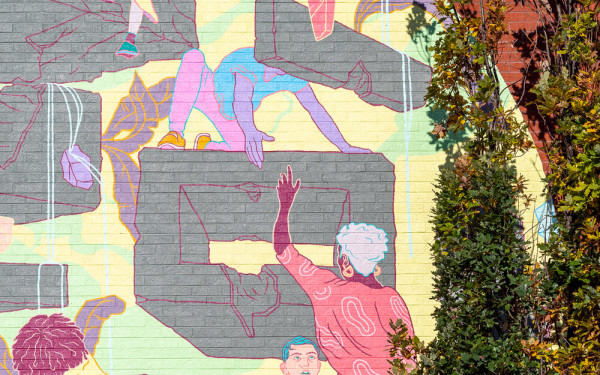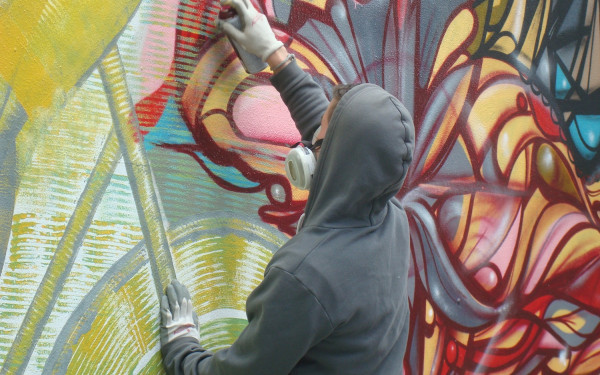Screaming at a Wall
The Strange Relationship Between Montreal and Its Graffiti
Known worldwide as one of the main veins for the arts in North America, Montreal and its well-established graffiti subculture have endured a long and arduous history.
From industrial train yards to the underground metros, from the alleys of Notre-Dame-de-Grâce to the so-called outdoor museum of the Plateau, from the infamous Turcot yards to the various busy highways that streak across the island, graffiti has left its mark on this city. It is an undeniable, unavoidable part of our culture, whether you like it or not.
A lot has changed since the mid 1980s when graffiti was first starting to really take hold in Montreal. The culture, as well as its relationship with the city, has changed dramatically.
Since the advent of legal walls, the commercialization of muralism and the evolution of graffiti events like Under Pressure, public opinion has become more open to the art form—or at least to interpretation of it.
Regardless of this newfound tolerance, the relationship between the city and its graffiti culture remains a strange, convoluted mess, and it might be entirely possible that neither side really knows how to deal with it.
A Mural, a Bylaw & Weird Politics
6_700_1086_90.jpg)
She is unavoidable—five stories tall, ethereal, dripping with Czech painter Alphonse Mucha’s turn-of-the-century Art Nouveau style and wrapped in a golden gown, she stands poised atop an unmistakable cityscape. She exudes strength, and is a symbol of beauty and optimism against her otherwise gentrified and graying surroundings. She is Notre Dame de Grâce—our lady of grace.
Situated on the large open wall of an apartment building at the corner of Madison Ave. and Sherbrooke St. W. (and on the cover this week), she is the newest mural installation by local graffiti company A’Shop.
“The city had a budget that was meant to be used in the context of graffiti prevention, though that can be done in many ways,” explains Kris Wilk (aka Fluke), veteran Montreal graffiti writer, and the man behind A’Shop.
“We decided to propose this mural and, surprisingly, it got accepted. So we took the idea of prevention as fuel, and we flipped it. Instead of preventing graffiti, we wanted to show an alternative. This is what can be done.”
Through funding from the city of Montreal and the borough, Prevention N.D.G.—a local not-for-profit that works with the community—hired A’Shop to do the mural. After agreeing on a location, the artists designed an image and the mural went up in under two weeks.
Though it has received plenty of praise from the community and significant attention from various media, the idea of a large-scale, legal, outdoor mural is nothing new.
However, the mural on Sherbrooke St. does come at an interesting time.
Just as the artists were spraying Our Lady’s final touches, NDG city council was busy finalizing a bylaw that, as of Oct. 20, will see large property owners (upwards of 300 m2, or apartment buildings larger than a six-plex) fined into the thousands of dollars if they fail to remove graffiti from their properties.
“[The mural] was completed just before our bylaw was put into effect,” said Susan Clarke, NDG city councillor at the helm of the borough’s anti-graffiti commission, and major proponent in seeing this new bylaw through.
“All that would have happened [if they hadn’t completed the mural in time] is that they would have applied to the borough council, and it would have met all the criteria.”
Odd as it may seem, the timing of this mural in light of the new bylaw might not even be a coincidence. After all, politicians, multinational corporations, and advertising agents have been using graffiti as a promotional tool for years.
“You can’t just applaud one side of something without understanding the rest of the culture—that’s very hypocritical,” said Wilk. “They only use what’s good for them politically.”
Sterling Downey, a legendary local graffiti artist, owner of Under Pressure magazine, and self-appointed/unofficial spokesperson for Montreal’s graffiti culture—who also mentored Wilk as a young graffiti writer almost 20 years ago—agrees with him, but adds that politics can serve both sides.
“That mural is part of a political campaign for specific graffiti writers who have grown in their careers to promote ‘this is where we are now,’” explains Downey.
“These things become promotional and educational tools to wake people up and say, ‘You love this mural, it represents the neighbourhood, and yeah, it’s done by a bunch of graffiti writers; but don’t forget that we used to be the same little shitheads that used to fuck up your stuff.’”
Though this pseudo-confession may raise eyebrows, Downey makes sure to add, “However, those little shitheads could grow up to be like this, and wouldn’t you want people like this around to mentor other youth, to work with them, and educate them?”
At a time when city council is making clear efforts to curb the ‘graffiti problem,’ a project like this mural, which was done by well-known graffiti writers, and sponsored by SubV, a controversial NDG graffiti supply shop, could be sending a mixed message.
“The battle isn’t necessarily to regain wall space, because in reality, nobody can really stop us from having these walls. So instead we’re just trying to build these bridges, and mend the gaps between our culture and what the citizen thinks.”
– Kris Wilk aka Fluke
Art vs. Vandalism: the Oxymoron of Legal Graffiti
As legal walls go up and simultaneously get taken down, and as the city allows murals to be painted by graffiti writers on designated private property, laws are put in place to fine the owners of similar properties for mismanagement.
Meanwhile, with graffiti festivals like Under Pressure, now into its 16th year, continuing to flourish, the definition of graffiti gets more and more confusing.
“Graffiti was and always will be illegal, or else it wouldn’t be graffiti,” says Wilk. “It has to remain that way and it will, because if you take it out of its illegal context, it’s not graffiti anymore.
“What we do is sell a derivative of that culture,” he explained. “When I do graffiti on a canvas for example, I’m not selling you graffiti—I’m selling you an imitation. Even if it’s a “Fluke” piece, what you’re getting is a copy, or a derivative of what I would do in the streets; it will never have the same essence of pure, illegal graffiti and that’s very important.”
Some may think of graffiti as a senseless, unorganized pastime for minors with a mischievous bent. In reality, the graffiti community runs on a strict code of ethics and there are some things you just don’t do. The concept of mainstreaming graffiti is a touchy topic amongst writers.
“A lot of artists won’t agree with making money off graffiti,” Wilk admitted. “I completely understand that, but I’m not making money off the graffiti culture—I’m making money off my own artwork.”
Downey is in the same boat as Wilk, in that he owns a magazine that has its roots in the graffiti culture and gets paid to do contracted murals.
He also agrees with Wilk that legality is a non-issue. However, Downey stresses that we should be cautious of using words like ‘legal’ because they inadvertently empower “the wrong people.”
Similarly, Downey warns of using heavy concepts like free speech and public space in regards to the graffiti community as a whole.
“There is no issue of free space here; people take it if they want it,” says Downey. “We have to keep in mind that a 15-year-old kid who’s going around tagging isn’t necessarily fighting for free space, or freedom of speech.”
Though he admits that there are some politically-minded writers who are active in promoting their beliefs, Downey believes that labeling a whole culture with these ideas would be dangerous, and incorrect.
“Public space, freedom of speech—all these things—it’s a very grey area,” he says. “I don’t really believe that graffiti has ever truly been about any of that.”
While it may come as a surprise to many people, much of the graffiti culture is based on the idea of education, mentorship and community. Many progressive artists like Wilk and Downey are taking these values and extending them out to the wider public in various forms.
“The battle isn’t necessarily to regain wall space, because in reality, nobody can really stop us from having these walls,” explains Wilk. “So instead we’re just trying to build these bridges, and mend the gaps between our culture and what the citizen thinks.”
Developing a Dialogue: Education Will Save the Relationship
“We still have to lead by example,” says Downey. “As a graffiti writer, and someone who is proactive in graffiti, and who did it illegally for a long time, I’m also active in educating about the culture.”
The corner of Hotel de Ville Ave. and St. Catherine St. E. in Montreal is the legendary location of the annual Under Pressure festival. The surrounding blocks are entirely consumed with some of the city’s best graffiti, and on the corner of the block, inside a large historic building, is the nerve center of Under Pressure.
The Under Pressure studio is two floors and thousands of square feet of high ceilings and concrete floors. The entire space is covered in ongoing graffiti projects. The studio space also functions as a public graffiti gallery.
“The goal of a space like [Under Pressure] isn’t to promote the culture of graffiti,” explains Downey. “The goal is to educate people on the fact that it exists, it’s a big deal, and you need to understand it.”
Both Downey and Wilk are deeply involved with the community, doing workshops, talking with youth and, most importantly, educating people on a culture that is otherwise elusive.
Downey stresses that more than anything, what is needed is a good dialogue and proper education in order for everyone to understand one another. Most importantly, this has to come from both the graffiti community and the city.
“All these walls [that divide the community] will come down as soon as there is communication and information,” says Downey. “We have to consider where everybody fits into the bigger picture of responsibility, of learning, and setting examples—graffiti writers included.”

2_900_598_90.jpg)
3_900_598_90.jpg)
4_900_598_90.jpg)
5_700_1054_90.jpg)
7_700_1054_90.jpg)
8_700_575_90.jpg)
_600_832_s.png)



